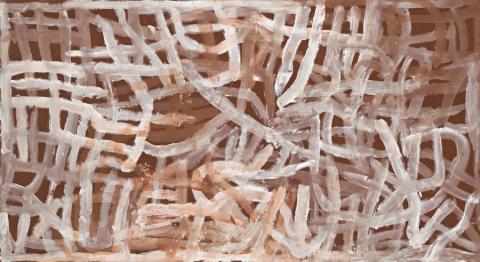UNTITLED (ALHALKERE), 1995
EMILY KAME KNGWARREYE
synthetic polymer paint on linen
110.0 x 201.0 cm
inscribed verso: Emily Kngwarreye, October 1995, Utopia N.T., Rodney Gooch, Alice Springs, MBA and bears label from Utopia Art, Sydney together with exhibition label from Emily Kame Kngwarreye: Alhalkere, Paintings from Utopia, Queensland Art Gallery
Commissioned by Rodney Gooch at Utopia in October 1995
Utopia Art, Sydney
Collection of Stephen Bush, New South Wales
Emily Kngwarreye’s Untitled (Alhalkerre) belongs to agroup of works commissioned by Rodney Gooch at Utopia in November 1995.
Emily Kame Kngwarreye: Alhalkere, Paintings from Utopia, Queensland Art Gallery, 20 February - 13 April 1998; Art Gallery of New South Wales, 15 May - 19 July 1998; National Gallery of Victoria, 22 September - 22 November 1998, cat. 78
Utopia: The genius of Emily Kame Kngwarreye, The National Museum of Art, Osaka, Japan, 26 February - 13 April 2008; The National Art Centre, Tokyo, Japan, 28 May - 28 July 2008; National Museum of Australia, Canberra, 22 August - 12 October 2008, cat. Y-5
Neale M., Emily Kame Kngwarreye: Alhalkere, Paintings from Utopia, Macmillan Publishers, Melbourne, 1998, cover illustration and p. 1 pl. 2 (cat. 78) and p. 53, fig. 53 (detail).
Neale M. (ed.), Utopia; The Genius of Emily Kame Kngwarreye, National Museum of Australia and The National Museum of Art, Osaka 2007, p. 36 & p. 89.
Kngwarreye was a senior Amatyerre law woman from the community of Atneltyeye, Utopia, north-east of Alice Springs in central Australia.Although she did not begin to paint on canvas until in her late 70's, her participation in ceremony and a lifetime of traditional cultural practice provided the basis of her artistic production. Her paintings are a tribute to the land where she was born (Alhalkerre). Utopia's modern-day art movement started in 1977 when a batik-making fabric workshop evolved as an extension to a women's adult education literacy course. Kngwarreye was a founding member of the Women's Batik Group. Encouraged by Jennifer Green and Julia Murray who taught Batik techniques to the women, the batiks produced were immediately recognised as containing a freshness and expressive vitality that had not been seen before in aboriginal art production. In this early communal project no one artist was singled out above the rest. All were encouraged equally to produce work. Over the following years, the Holmes sponsored a series of similar projects which launched the Utopia artists out to an awaiting public. Kngwarreye's paintings began to attract attention partly due to the prominence gained by the reproduction of her first canvas, Emu woman, 1988-89, on the cover of The Summer Project catalogue for the exhibition att he S.H. Ervin Gallery in Sydney in 1989. This work was produced four months earlier as part of a community wide program initiated by Rodney Gooch on behalf CAAMA that resulted in the production of 81 paintings. In 1990 a joint artist-in-residence program and exhibition of the works of Kngwarreye and Louie Pwerle was held at the Perth Institute of Contemporary Arts. Also in that year Kngwarreye had her first solo exhibition at Utopia Art Sydney.
In the 1990s Emily Kame Kngwarreye emerged as one of Australia's leading painters and her works were sought after on an unprecedented scale. Her prolific output barely keeping up with the demand. Her brush strokes revealed a strength and sureness of hand that delivered an exuberance of gesture. This was strong confident painting. Her paintings were constructed of various elements that over time were added to or eliminated from the surface of the canvas. Underlying grids structure the pictures, sequences of dots aligned between or over lines, dashes and linear marks, meandering lines, and areas of dotting that allow a build-up of layers of colour. These elements makeup the artist's lexicon and are used separately or in varying combinations thus allowing her work to evolve and be constantly fresh.
Untitled (Alhalkerre), 1995, is reductive in the use of her lexicon. Layers of broad powerful brush strokes are layered upon an ochre coloured ground, the palette simply ochre and white and variations between creating layers of ochre, burnt orange, rust and cream. It is the gesture, the way that the paint has been applied that dominates this painting. The work exudes energy and the sweeping lines express a movement that takes your eye across all parts of the canvas. Despite being a large painting, over two metres long, the arcs created by the sweep of the of the artist's outstretched arm lend the painting a human scale while describing a broad stretch of landscape. This is a striking instance of body and country becoming one; a woman drawing her country with her body's reach.’1
Untitled (Alhalkerre) can be regarded as one of the great masterpieces in Australian Aboriginal art.
1. Smith, T., Kngwarreye woman abstract painter in Isaacs, J. Et al., Emily Kngwarreye Paintings, Craftsman House, Sydney 1998 p. 32
